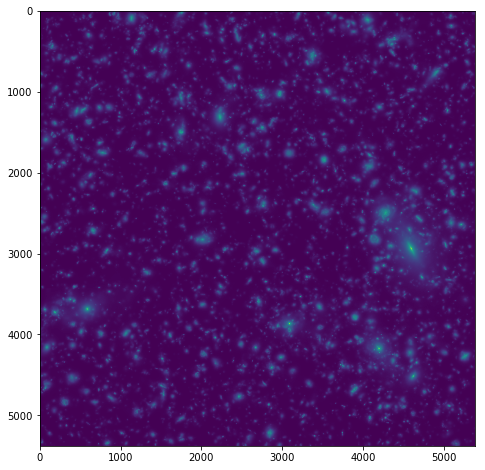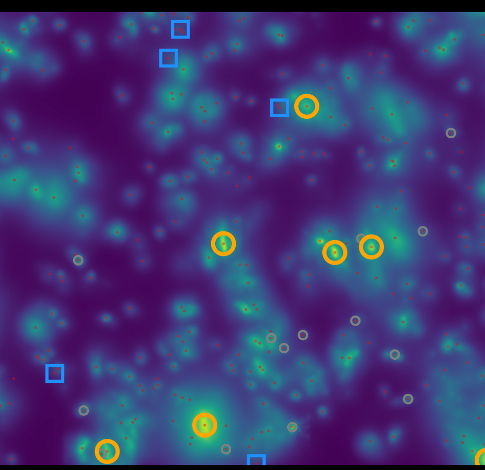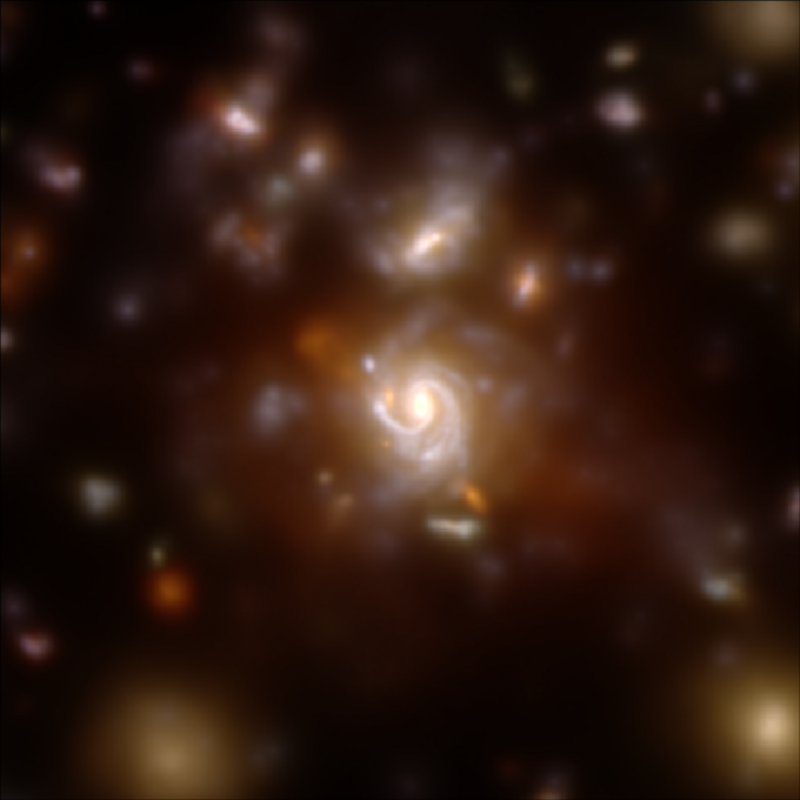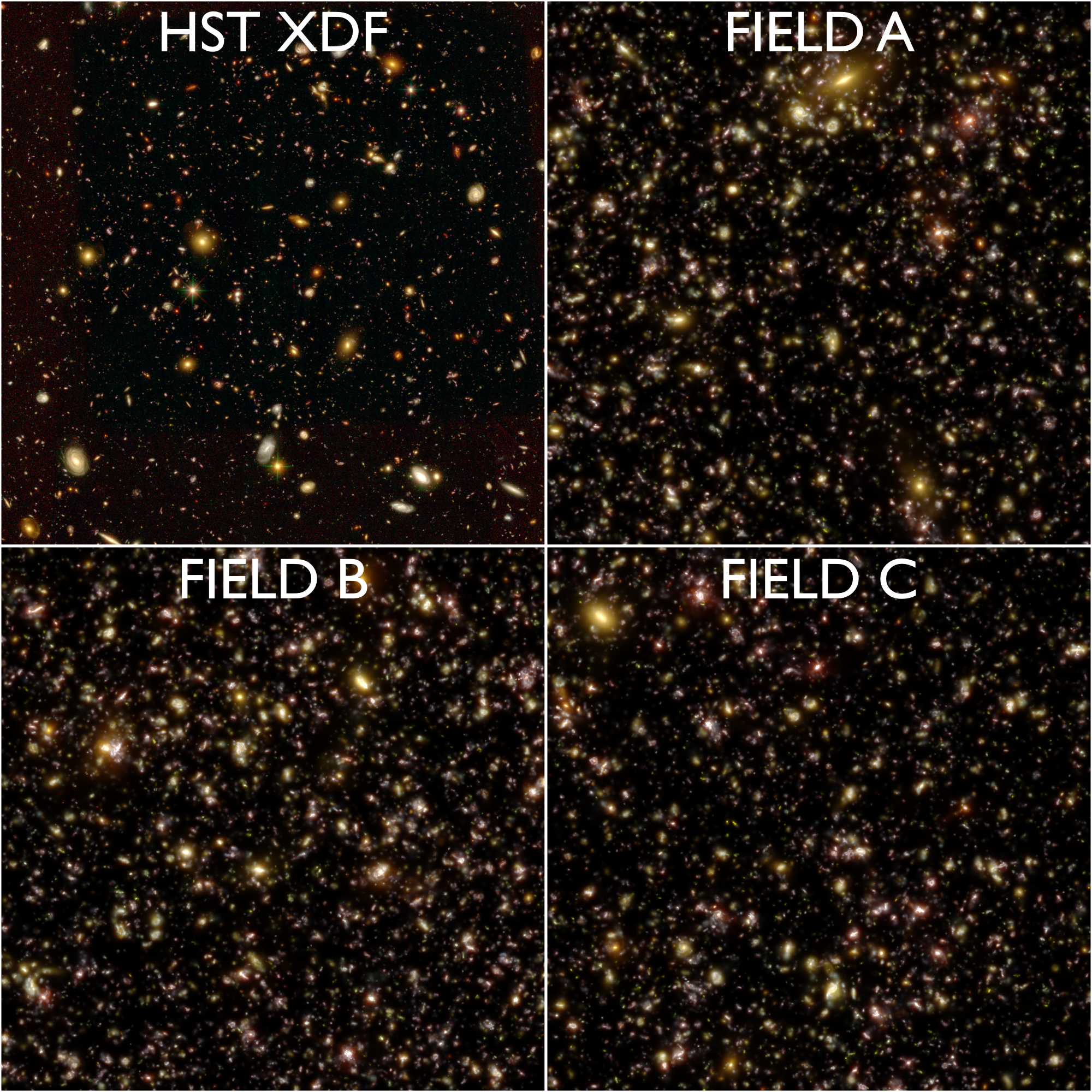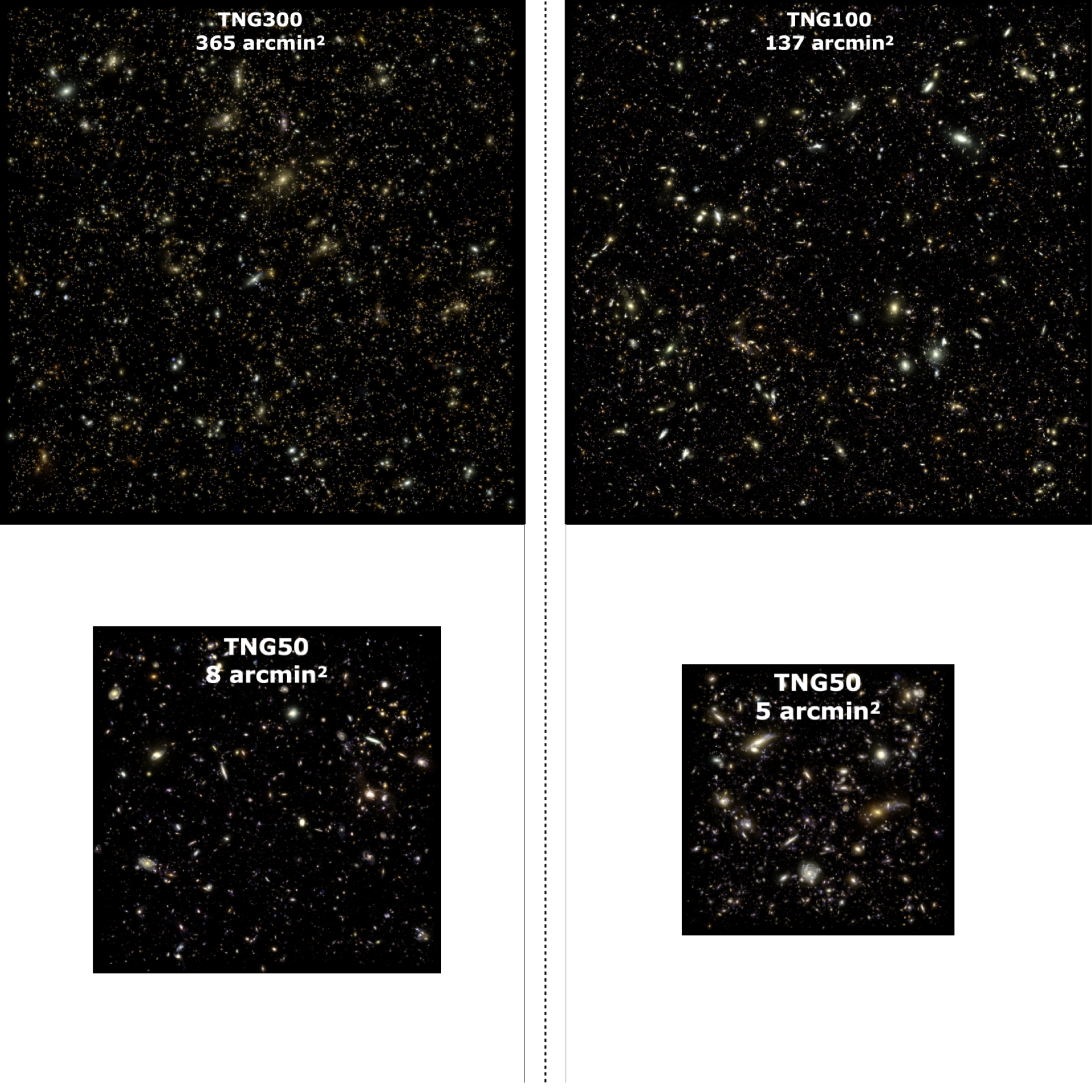Mission Overview
Illustris Simulated Deep Fields (ILLUSTRIS)
Primary Investigator: Gregory F. Snyder
HLSP Authors: Gregory F. Snyder
Released: 2022-08-19
Updated: 2022-08-19
Primary Reference(s): Snyder et al. 2017, Pena & Snyder 2021
DOI: 10.17909/T98385
Citations: See ADS Statistics
Slideshow
Overview
This page hosts synthetic deep survey images from the Illustris Project cosmological simulations of galaxy formation. By projecting a line of sight through a periodic volume, the team constructed realistic mock surveys which preserve the predicted geometry of the simulations. With the emergence of large hydrodynamical simulations of galaxy formation, the team can now create these mock galaxy surveys with detail down to the size scales and distances revealed by HST, and in the future, those JWST and WFIRST will reveal. The Illustris Project consists of hydrodynamical simulations of galaxy formation in a volume 106.5 Mpc across, with detail resolved down to sub-kpc scales. Using the Arepo code, Illustris applied galaxy physics consisting of cooling, star formation, gas recycling, metal enrichment, supermassive black hole growth, and gas heating by feedback from supernovae and black holes. By converting simulations like these into synthetic observations, the team interprets HST observations with complex models of galaxy assembly, plan ahead for future missions, and directly contrast valuable survey data with our theoretical understanding of the physics behind the formation of galaxies.
Here, the team presents "mock ultra-deep fields", each 2.2 to 19 arcminutes across, in common wide filters used by HST and JWST, as well as in filters expected to be used widely by observers with the Nancy Grace Roman space telescope (formerly "WFIRST"). The team presents mock lightcones from both the original Illustris-1 simulation, as well as from the IllustrisTNG suite of simulations. For each image, the team also provides the simulation catalog from which they generated each image, enabling users to locate sources, link them to intrinsic simulation quantities, and conduct analyses across observation and theory space.
Data Products
Illustris-1 Lightcones
The deep fields are provided as multi-extension FITS files. For the Illustris-1 lightcones, files are named with the following convention:
hlsp_illustris_<observatory>_<instrument>_<field>_<filter>_v1_lightcone.fits
where:
- <observatory> is one of "hst", "jwst", or "roman".
- <instrument> is one of "acs", "wfc3", "miri", "nircam" or "wfidrm15".
- <field> is the geometry/selection, described below.
- <filter> is the simuated filter, e.g., "f435w"
The Illustris-1 FITS files contain the following HDUs:
- "IMAGE_NOPSF": Raw image without PSF or noise.
- "SimulationAssumptions": URL links to Illustris documentation and API.
- "MockDataAssumptions": Header contains code and parameter choices for creating mock images.
- "IMAGE_PSF" : [Optional] Same image, now convolved with model PSF from TinyTim or WebbPSF.
- "MODELPSF" : [Optional] The PSF model at the same pixel scale as HDU 3 "IMAGE_PSF".
- "Catalog" : Lightcone Catalog, containing intrinsic simulation info, including galaxy ID numbers, image positions, and other info.
- "CatalogDocumentation": Strings containing explainers of catalog columns.
For more information, consult the README file and the GitHub repository.
Note: the original Illustris-1 files naming scheme began with "hlsp_misty_illustris_..." and have been updated to "hlsp_illustris..." to be compliant with HLSP practices.
TNG Lightcones
For the TNG lightcones, the mock image files are named according to the following convention:
hlsp_illustris_<observatory>_<instrument>_<field>_<filter>_v1_sim.fits
where:
- <observatory> is one of "hst", "jwst" or "multi".
- <instrument> is one of "acs", "wfc3", "nircam" or "multi".
- <field> is the geometry/selection, described below.
- <filter> is the simulated filter (e.g., "f435w"), or a description of the simulation output (i.e., one of "mstar" (stellar mass) or "sfr" (star formation rate)).
The TNG mock image FITS files have the following HDU structure:
- <observatory>_<filter> (e.g. jwst_f200w): mock image
- InputData: original lightcone data, corresponding to data from the associated lightcone.txt file
- OutputData: final resulting catalog after mock image creation
The input TNG lightcone catalogs are named according to the following convention:
hlsp_illustris_multi_multi_<field>_multi_v1_lightcone.txt
where:
- <field> is the geometry/selection, described below.
Color-composite renderings of the associated fields are named according to the following convention:
hlsp_illustris_multi_multi_<field>_rgb_v1_sim.pdf
where:
- <field> is the geometry/selection, described below.
The geometry/selection of the three Illustris-1 fields is derived from the three "Thin" lightcones defined in Snyder et al. (2017). For example, "mag30-fielda-11-10" corresponds to Field A from that paper. The string "mag30" refers to the selection of Illustris subhalos included in the mock image. For these files, the selection is based on the rest-frame g-band apparent magnitude of the source, such that g < 30.0. The geometry of the TNG fields is derived from the “Wide” lightcones in Snyder et al. (2017), as well as from Peña & Snyder (2021).
Data file types:
| _lightcone.fits | Illustris-1 lightcone |
| _sim.fits | Mock image for TNG lightcone |
| _lightcone.txt | Input TNG lightcone catalog |
| _sim.pdf | Color composite renderings of TNG fields |
Data Access
cURL scripts for downloading Illustris-1 lightcones by simulated observatory are included in the table below. The estimated download size and number of files is indicated in the table header.
| Illustris-1 Lightcones | |||
|---|---|---|---|
|
HST cURL Scripts (~4 GB, 11 files) |
JWST cURL Scripts (~3 GB, 17 files) |
Roman cURL Scripts (~1.4 GB, 6 files) |
|
| Field A | Field A | Field A | |
| Field B | Field B | Field B | |
| Field C | Field C | Field C | |
cURL scripts for downloading mock image files for the TNG lightcones by observatory, as well as the simulation and color-composite renderings, are included below. The estimated download size and number of files is indicated in the table header. A script for downloading all lightcone catalog files is also included (note: not all fields with lightcone catalog files have associated mock image files).
| TNG Lightcones | ||||
|---|---|---|---|---|
| Field |
HST (~0.5 GB, 6 files) |
JWST (~1 GB, 7 files) |
Simulation Output (~0.5 GB, 2 files) |
Color-composite Rendering |
|
tng50-12-11-xyz_5sqarcmin |
HST cURL | JWST cURL | Simulation Output cURL | Color-composite rendering |
|
tng50-11-10-zyx_8sqarcmin |
HST cURL | JWST cURL | ||
|
tng50-11-10-yxz_8sqarcmin |
HST cURL | JWST cURL | ||
|
tng50-11-10-xyz_8sqarcmin |
HST cURL | JWST cURL | ||
|
tng100-7-6-yxz_137sqarcmin |
HST cURL | JWST cURL | ||
|
tng100-7-6-xyz_137sqarcmin |
HST cURL | JWST cURL | ||
|
tng300-6-5-xyz_365sqarcmin |
HST cURL | JWST cURL | ||
| cURL Script to download all lightcone catalogs | ||||

